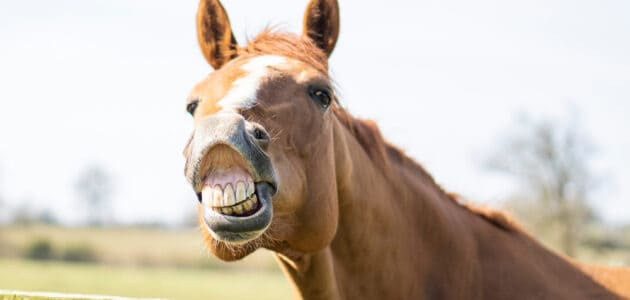

Horses may not speak, but they have a complex language of facial expressions that tell us exactly how they’re feeling. From soft eyes to flared nostrils, learning to interpret these subtle cues can improve communication and deepen your bond with your horse.
Understanding horse facial expressions can help you:
✔️ Recognize when your horse is happy, relaxed, or engaged.
✔️ Spot early signs of stress, pain, or frustration.
✔️ Improve training by responding to their emotional state.
Let’s break down the key facial expressions and what they mean.
Horses rely heavily on non-verbal communication. Their ears, eyes, nostrils, and mouth work together to express emotions, from calm contentment to fear and aggression.
Unlike dogs or cats, horses do not wag their tails or bark to show emotion, making facial cues one of the most reliable ways to understand their mood.
🐴 Calm and relaxed horses have soft facial features and slow movements.
🐴 Nervous or stressed horses show tension around the eyes, mouth, and nostrils.
🐴 Fearful or aggressive horses use more dramatic signals, such as flared nostrils and pinned ears.
By learning to recognize these early warning signs, you can prevent misunderstandings and ensure a positive experience for both you and your horse.
👁 Soft, Half-Closed Eyes – Indicates relaxation and comfort. A horse in this state is likely feeling safe and at ease.
👁 Wide, Alert Eyes with Normal Blinking – Shows curiosity and attentiveness. They are aware of their surroundings but not fearful.
👁 Whites of the Eyes Showing – A sign of fear, anxiety, or pain. This can happen when a horse is spooked, nervous, or highly stressed.
👁 Rapid Blinking or Squinting – Could indicate discomfort, confusion, or even a headache.
💡 Tip: If your horse’s eyes suddenly widen, look around—something may have startled them.
A horse’s ears are like emotional antennas —they constantly move and shift to express what they’re feeling.
👂 Ears Forward – Shows interest and curiosity. They are engaged with something ahead.
👂 Ears Relaxed to the Side – Indicates calmness and contentment. This is common in a horse at rest.
👂 Ears Rapidly Flicking Back and Forth – Suggests uncertainty or nervousness. The horse may be on alert but unsure of what to do.
👂 Ears Pinned Flat Back – A strong sign of anger, irritation, or aggression. If paired with bared teeth, the horse may be about to bite or kick.
👂 One Ear Forward, One Ear Back – The horse is paying attention to multiple things at once. This is often seen when they are listening to both their rider and the environment.
💡 Tip: If a horse’s ears are pinned back for a long time, check for discomfort or irritation—something may be bothering them.
A horse’s nostrils can give clues about their mood and stress levels.
🐴 Relaxed, Soft Nostrils – This is a sign of a calm and comfortable horse.
🐴 Slightly Flared Nostrils – Indicates excitement or alertness. If combined with forward ears, the horse is likely interested in something nearby.
🐴 Heavily Flared Nostrils – Could mean fear, stress, or physical exertion. If your horse’s breathing is rapid and their nostrils stay flared, they may be overheated or anxious.
🐴 Wrinkled or Pinched Nostrils – A sign of tension, pain, or irritation. If your horse shows this expression often, it may be worth checking for discomfort or health issues.
💡 Tip: Some horses have naturally more flared nostrils due to their breed—but sudden changes in nostril shape often signal a shift in mood.
The mouth is one of the most overlooked areas when reading horse expressions, but it’s extremely telling.
🐴 Relaxed Lips with Soft Jaw – A sign of calmness and trust.
🐴 Tight Lips or Clenched Jaw – Indicates tension, discomfort, or stress.
🐴 Chewing or Licking Without Food – A sign that a horse is processing information. This is common after training sessions or when they’re trying to understand something new.
🐴 Baring Teeth Without Playfulness – A strong warning sign of aggression or frustration. If combined with pinned ears, the horse may be ready to bite.
🐴 Droopy or Slack Lips – A sign of relaxation or sleepiness. Some horses even nap with their lips slightly hanging open.
💡 Tip: If your horse is chewing air or grinding their teeth, it could indicate stress or discomfort, especially if they are saddled or bridled.
One of the most important things you can learn is how to recognize facial tension in horses, as it often signals pain or stress.
❌ Tense or pinched lips – Indicates discomfort.
❌ Tight nostrils and furrowed brow – Could signal pain or anxiety.
❌ Frequent yawning or grinding teeth – May be a sign of gastric ulcers or dental issues.
❌ Lack of eye movement/blinking – A sign of pain, exhaustion, or stress.
If your horse’s facial expressions change suddenly or seem abnormal, it’s always best to check for underlying health concerns.
By understanding your horse’s facial expressions, you can:
✔️ Recognize when they are comfortable, engaged, or happy.
✔️ Spot early signs of stress before they escalate.
✔️ Improve training by responding appropriately to their mood.
✔️ Strengthen your connection through better communication.
Horses communicate constantly —we just have to learn how to listen. By paying attention to their eyes, ears, nostrils, and mouth, you’ll be able to better understand what they need and how they feel.
💡 Final Tip: Spend time observing your horse’s facial expressions in different situations. The more you watch, the better you’ll become at reading their emotions —just like learning a new language!
Get a photoshoot with edited photos
Book by to secure this special rate